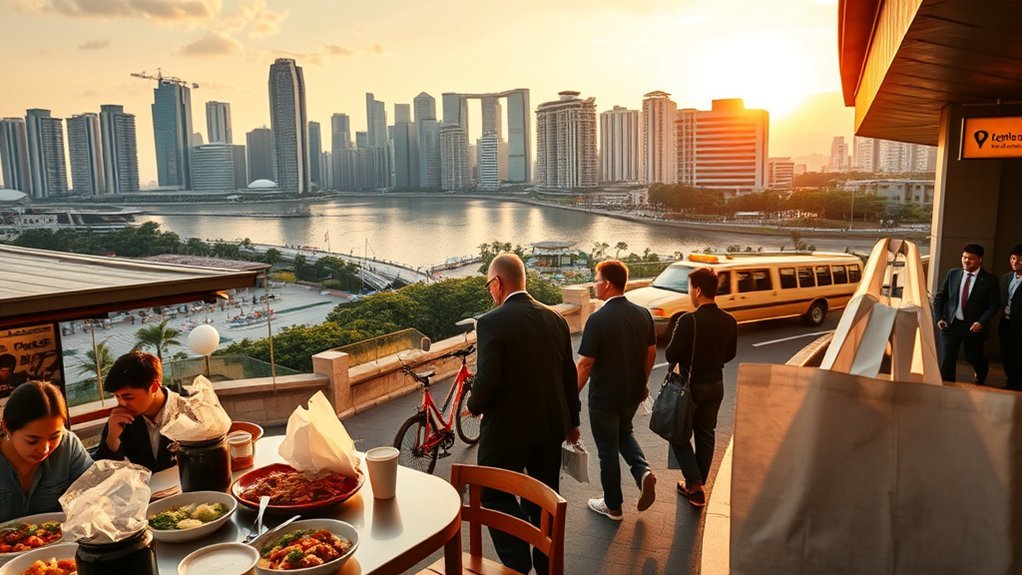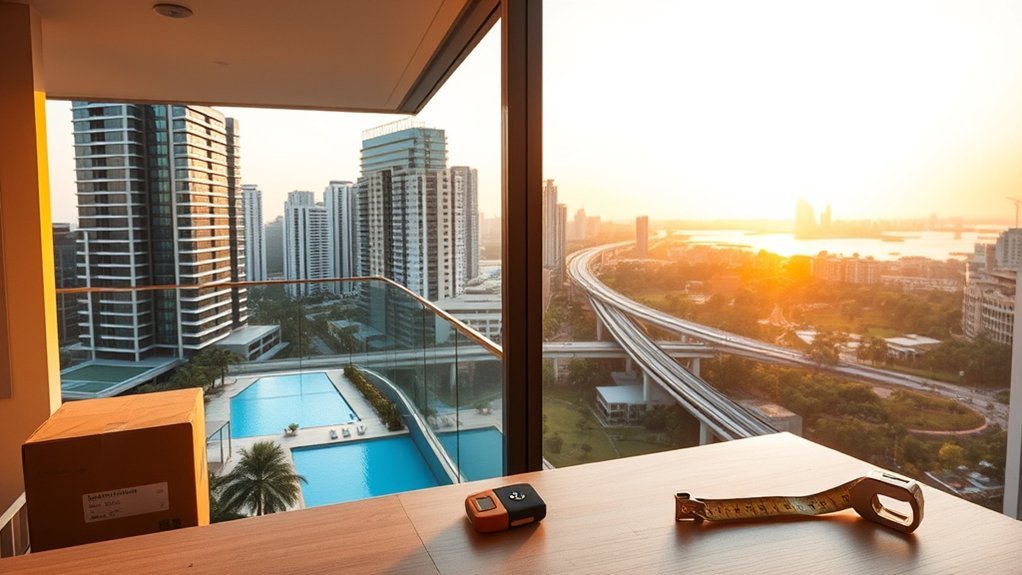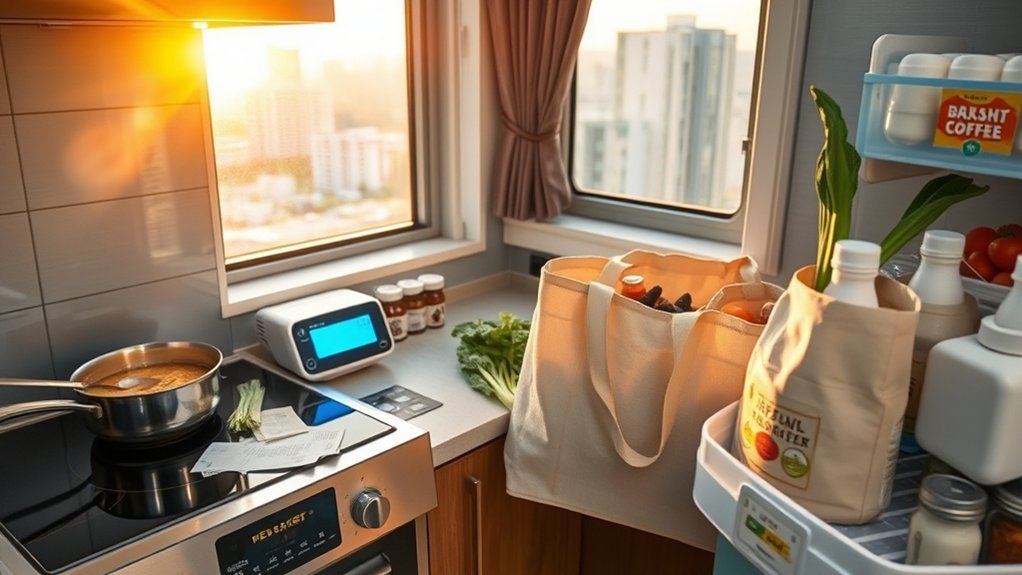You’ll typically need SGD 3,000–6,000 per month to live comfortably in Singapore, but housing drives costs: one‑bed city rentals run SGD 2,500–4,000 and three‑beds exceed SGD 7,700 downtown. Food, utilities and transport add SGD 300–800 monthly, while healthcare, insurance and education can raise expenses considerably. Expect GST at 8% and high car costs from COEs. Compare these figures to your salary to assess affordability; keep going to get detailed breakdowns and tips.
Overview of Living Costs and Salaries in Singapore

Although Singapore offers strong salaries—mid-level managers earn about SGD 9,490 (USD 7,000) monthly and personal tax is capped at 22%—you’ll face significantly higher living expenses than in the UK: overall costs are roughly 39.1% higher and rent averages about 181% more.
Singapore pays well—mid-level managers earn ~SGD 9,490—but costs are much higher, with rent around 181% above UK levels.
You should benchmark monthly expenses against that average salary: city-center 1BR rent ranges SGD 2,500–4,000, outside-center SGD 1,500–2,500, while utilities add ~SGD 150–300 and public transport is typically SGD 40–50 for frequent users.
Your disposable income depends on housing choice and schooling: education costs at international schools run USD 10,000–15,000 per semester, often the second-largest outlay after rent.
Analyze net pay versus fixed costs to model affordability—subtract rent, utilities, transport, and education from take-home pay to estimate realistic savings.
In short, Singapore’s average salary offsets part of the high cost of living, but you’ll need targeted budgeting to maintain desired standards without eroding savings.
Housing and Rental Prices for Expats

You’ll see wide rent ranges: a 1‑bed in the city center averages SGD 4,610.81 versus SGD 3,192.45 outside, and a 3‑bed for a family can reach SGD 8,687.01 downtown or about SGD 5,468.75 outside.
To cut costs many expats choose flatsharing, with shared rooms typically from SGD 800–1,200 monthly, but expect a highly competitive market and large price variance by location and amenities.
We’ll also compare the financial trade‑offs of buying versus renting given rents up to 210.1% higher than in the UK.
Typical Rent Ranges
One-bedroom city-center rentals typically run SGD 2,500–4,000 per month, while outside the center they drop to about SGD 1,500–2,500.
Three-bedroom units average roughly SGD 7,722 in the center and SGD 4,685 outside.
You’ll find rental prices substantially higher in expat hotspots like Orchard Road, Holland Village and Tanglin, so factor that into your monthly cost of living.
Compared with the UK, rents for expats can be up to 210.1% higher, making housing a leading component of the high cost of living here.
If you’re an expat who moves for work, expect to allocate a large share of income to rent.
Consider neighborhood trade-offs carefully; proximity to amenities drives premiums and influences total living costs.
Shared Housing Options
Given central one- and three-bedroom rents, many expats cut costs by sharing flats: one-room rentals typically run SGD 800–1,200 monthly, while a central one-bedroom starts around SGD 2,500, so splitting a unit can halve or better your housing bill. You’ll find shared housing options concentrated in central locations—Orchard Road, Tanglin, Holland Village—where flat-sharing arrangements let expats access amenity-rich areas despite high rental costs. The rental market has seen increases up to 70%, so a cost-effective solution is essential. Assess room size, utilities split, contract terms, and commute impact. Use platforms and local agents to compare offers and vet roommates; doing so reduces housing expenses while maintaining proximity to work and social hubs.
| Area | Typical Room Rent | Notes |
|---|---|---|
| Orchard/Tanglin | SGD 900–1,300 | Central locations |
| Holland Village | SGD 850–1,200 | Popular with expats |
| Central 1-bedroom split | SGD 1,250+ | Cost-effective solution |
Buying Vs Renting
If you’re weighing buying against renting in Singapore, run the numbers: central one-bed flats rent for about SGD 2,500–4,000/month (outside center SGD 1,500–2,500), three-beds average ~SGD 8,688 in the city and ~SGD 5,469 outside, while purchase prices—around USD 14,373/m² in 2022—plus Buyer’s Stamp Duty and Additional BSD can push upfront costs far beyond several years’ rent.
So many expats offset high rents by sharing or moving to non-central areas. You’ll compare ongoing monthly rent and accommodation flexibility against large capital outlay and transaction taxes.
Buying can be an investment if you’ll stay long term, but property prices and Buyer’s Stamp Duty/Additional Buyer’s Stamp Duty amplify expenses. For short-to-medium stays, renting or shared housing usually optimizes cash flow and risk.
Food, Utilities and Everyday Essentials

You’ll find groceries like a gallon of milk at about SGD 9.50, a loaf of bread for SGD 1.80, and a dozen eggs around SGD 2.81, which helps benchmark your weekly food spend.
Utilities for an average apartment run roughly SGD 141/month, with internet adding about SGD 34.61, and public transport or occasional dining choices (mid-range meal for two ~SGD 12, McMeal SGD 5–20) shaping your monthly discretionary outlay.
Use these figures to compare shopping habits, utility plans, and dining frequency to estimate your realistic monthly budget.
Groceries and Market Prices
You’ll find groceries and market prices reflect import dependence and retailer markup.
Basic grocery items offer value compared with many Western cities, lowering routine food expenses if you buy staples. Yet imported dairy and alcohol can sharply raise your average cost per shopping trip.
When planning monthly costs for living in Singapore, include varied item pricing: rice and eggs offset costly milk and wine.
Utilities and public transport fares influence overall budgets too; metro and bus fares range roughly US$0.99–US$2.26.
Monitor local wet markets and supermarket promotions to optimize spending, balancing convenience against lower market prices for fresher produce.
Utilities and Monthly Bills
Although Singapore keeps many everyday costs predictable, your monthly bills still hinge on lifestyle and choices: utilities for a typical apartment average SGD 140.99, home internet about SGD 34.61, and basic groceries—milk SGD 9.50/gal, bread SGD 1.80/loaf, rice SGD 1.17/lb, eggs SGD 2.81/dozen—round out routine food spending; add public transport at roughly SGD 2.00 per one-way ride or SGD 120 for a monthly pass to estimate total recurring expenses.
You’ll track utilities (electricity, water, gas) and home internet as fixed components of living expenses, while basic grocery items vary by diet and shopping habits.
Use the figures below to model monthly cash flow and identify where to trim costs or reallocate budget for discretionary spending.
- Fixed: utilities (electricity, water), home internet
- Variable: groceries, occasional transport top-ups
- Optimization: compare providers, bulk buy staples
Eating Out and Dining
When balancing convenience and cost, eating out in Singapore gives you clear trade-offs: hawker-center meals typically run SGD 5–10, a basic lunch in the business district is about SGD 12, and a three-course dinner for two at a mid-range Italian restaurant averages SGD 115, while grocery staples like a kilogram of tomatoes (SGD 2.89), a liter of whole milk (SGD 2.46), and a loaf of bread (SGD 1.80) let you estimate the tipping point where cooking becomes cheaper than dining out. You’ll compare eating out versus groceries using grocery prices and everyday essentials; budget-friendly meals at hawker centers reduce food spend, while frequent three-course dinner outings raise it. Consider average monthly utility bills (SGD 150–300) and household income when modeling monthly food spend.
| Item | Typical Price (SGD) | Role |
|---|---|---|
| Hawker meal | 5–10 | Budget-friendly meals |
| Lunch (CBD) | 12 | Basic lunchtime meal |
| Dinner for two | 115 | Three-course dinner |
Healthcare, Insurance and Medical Costs

Because healthcare costs in Singapore have been rising—MediShield Life premiums have jumped as much as 35.4% in recent years—you should plan insurance carefully: public hospitals and polyclinics offer subsidized care, while private clinics deliver faster service at much higher prices, so expats typically need private coverage.
With rising healthcare costs and big MediShield Life premium hikes, expats should secure private cover for faster, less costly care.
The healthcare system mixes subsidized healthcare with premium private healthcare; MediShield Life covers basic risk but won’t replace extensive health insurance. Expect international plans from SGD 566.08 to SGD 3,085.73 annually depending on limits, inpatient/outpatient cover and rider options.
Medisave helps citizens; you won’t benefit as an expat. Factor in potential medical evacuations — costly if not covered. Prioritize plan limits, network hospitals, evacuation and repatriation clauses, and co-insurance rates. Review premium inflation history and claims processing times.
Choose cover that aligns with expected healthcare services usage and risk tolerance to avoid unexpected out-of-pocket exposure.
- Compare premiums, limits and network hospitals
- Verify medical evacuations and repatriation clauses
- Evaluate co-insurance, deductibles and rider needs
Education and Schooling Expenses

If you’re budgeting for children in Singapore, plan for wide-ranging costs driven by school type and residency status: the education system covers primary, secondary and post-secondary levels, taught mainly in English.
If you choose government-aided schools, expect government-aided school fees near SGD 255/month for permanent residents; Asian expatriates pay about SGD 515 and non-Asian expatriates roughly SGD 875.
International schools set tuition fees widely—from roughly USD 5,300 to USD 40,000 annually—depending on curriculum and boarding.
Beyond tuition fees, factor books, uniforms and extracurricular activities, which can materially raise the overall expense.
Expatriate children seeking mainstream enrollment must complete an application through the Admissions Exercise for International Students (AEIS), including assessments that affect placement timing and potential interim costs.
To estimate your household budget, tally school type, residency status, targeted international schools’ fee schedules and likely extracurricular and material costs.
That gives a clearer, data-driven projection of education’s share of living expenses.
Transport, Taxes and Tips for Budgeting

Although public transport in Singapore is efficient and relatively affordable, you’ll need to budget for regular fares (single trips S$1–S$3, monthly passes around S$120) and expect typical monthly usage to cost about S$40–50.
Owning a car is considerably more expensive due to Certificate of Entitlement (COE) premiums often pushing total vehicle costs well above S$100,000. You should treat transport as a discrete line in your expenses in Singapore: choose public transport to control cost and avoid the high costs of car ownership.
Factor Goods and Services Tax (GST, 8%) into recurring purchases and services, and run scenarios with both resident and non-resident personal income tax rates (0–22% for residents; non-residents typically 15%+).
For practical budgeting, model monthly transport, utilities, housing, and GST-affected spending to estimate net disposable income.
Use these quick action points:
- Allocate S$40–120 monthly for public transport depending on usage.
- Model tax brackets and GST impact on discretionary spend.
- Prioritize public transport to limit high costs and stabilize living expenses.
Frequently Asked Questions
Is Living in Singapore Expensive?
Yes — you’ll face high costs: overall living is about 39.1% pricier than the UK, city-center rent averages SGD 4,610, utilities SGD 150–300, transport SGD 1–3 per trip, requiring solid salary planning.
How Much Is Rent in Singapore in US Dollars?
A 1‑bed in Singapore costs about US$3,460/month in the city and US$2,391 outside; a 3‑bed runs roughly US$6,472 downtown and US$4,066 outside. You’ll want to budget accordingly for premiums.
Can US Citizens Live in Singapore?
Yes — you can live in Singapore if you obtain an Employment Pass, Dependent Pass, or Permanent Residency; evaluate visa eligibility, employer sponsorship, tax implications, and family needs, since housing and schooling substantially affect your budget.
What Salary Do You Need to Live in Singapore?
You’ll typically need SGD 3,500–6,000 monthly as a single, and SGD 6,000–12,000 for a family of four; use the mid-level manager average (~SGD 9,490) to benchmark budgeting and housing decisions.
Conclusion
You’ll find Singapore’s price tag reasonable if your salary matches its cost — think Hong Kong-level rents but Swiss-level salaries. Balance housing, food, transport and healthcare against tax-efficient pay; expect rents to dominate your budget, then groceries and insurance. With public transit, subsidies and employer benefits, you can trim costs. Like a sailor charting precise coordinates, use salary, rent and recurring bills to plot a sustainable monthly course and avoid sudden storms.


